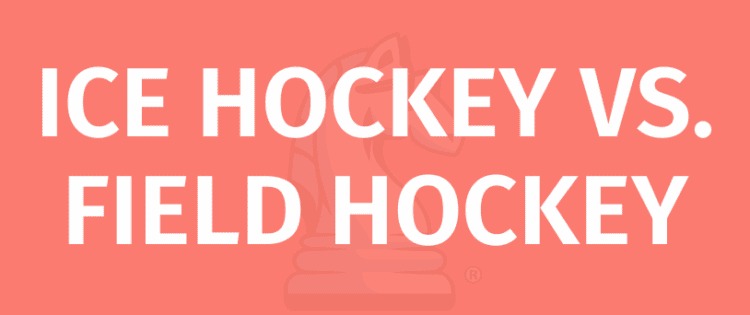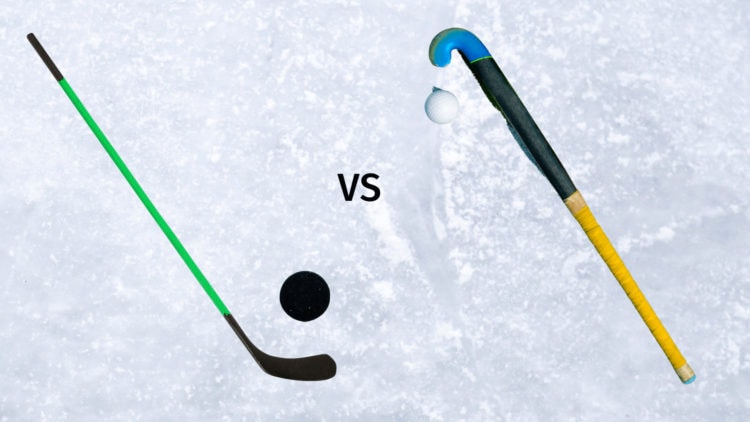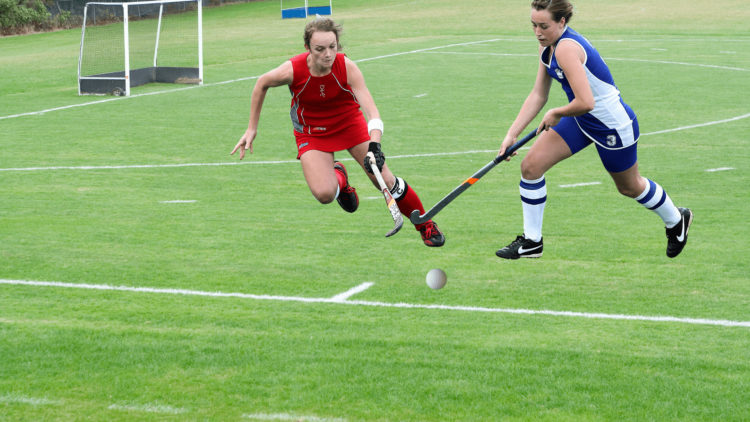
INTRO
From an outsider’s perspective, ice hockey and field hockey might seem like the same game played on a different surface. Although the objective of each game is identical (to score more goals than the opposing team), the two stick-based sports have distinct and contrasting rules that significantly alter the pace of the game.
PLAYING SURFACE
Heavily implied by the names, the most evident difference between ice hockey and field hockey is the playing surface.
ICE HOCKEY
Ice hockey is played on an enclosed surface of ice known as an “ice rink”. This hockey rink is surrounded by barriers and shatter-proof glass windows instead of a traditional out-of-bounds line, uniquely allowing players to utilize the walls during play. Despite the absence of an out-of-bounds border, the ice still features prominent red-and-blue-painted markings to dictate various rules.
FIELD HOCKEY
Field hockey games must be played on artificial turf fields at the competitive level. While some amateur matches can be played on grass fields, artificial turf is favored because it allows much faster ball movement.
EQUIPMENT

All hockey sports feature the three following items:
- A ball/puck
- Stick (to hit the ball with)
- Nets/goals (to hit the ball into)
Both ice hockey and field hockey feature these three pieces of equipment, but the items are quite different between the sports.
ICE HOCKEY
Ice hockey features a ball known as a “puck”. Unlike a traditional ball, a puck is a flat rubber disc that slides instead of rolls. This design consideration is mainly the result of the icy playing surface being largely devoid of friction, meaning the ball doesn’t need to roll to move.
Hockey sticks are generally composed of wood or carbon fiber and are fundamentally symmetrical, allowing players to utilize both sides of the stick.
Since ice hockey is played on ice and features frequent impacts with other players, athletes must additionally wear the following equipment:
- Ice skates
- Helmet with visor
- Shoulder pads
- Gloves
- Protective/padded pants
- Shin pads
- Elbow pads
- Mouthguard
Ice hockey goalies wear extra padding to protect themselves from fast-flying pucks (up to 105 MPH!). This additional equipment includes thicker leg pads, larger arm guards, a glove that functions as a net to catch the puck, a full face mask, and an extra-large hockey stick.
FIELD HOCKEY
Field hockey utilizes a typical round plastic ball instead of a puck.
A field hockey stick uniquely resembles an inverted walking cane; the end of the stick used to hit the ball is curved and rounded. However, unlike the multi-faced ice hockey stick, field hockey players cannot use the rounded surface of the stick to hit or pass the ball. Instead, they must use the flattened side of the stick to contact the ball.
Unlike ice hockey, field hockey does not require extensive use of protective gear. However, the following equipment is highly recommended:
- Field hockey cleats or turf shoes
- Elbow pads
- Protective face mask or safety goggles
- Mouthguard
- High socks and shinguards
Similarly to ice hockey, however, goalies are required to wear additional gear. Interestingly, both sports require goalie gear that is extremely alike: a full face mask, massive leg guards, and huge gloves/hand pads.
GAMEPLAY
In all hockey sports, the game’s objective is simple – score more points than the opposing team by knocking the ball/puck into the other team’s net. Like soccer or lacrosse, players must get themselves into scoring position by moving the ball upfield past defenders using speed and passes. Despite these glaring similarities, both sports possess strict rule differences that greatly dictate the pace of the game.
PLAYER POSITIONS
ICE HOCKEY

There are three ice hockey players on the ice at any given time. Three of these players are forwards, two are defense, and one is the goalie.
- Forwards: This is the position primarily responsible for scoring on offense.
- Defense: These two players are responsible for keeping the puck away from the goalie and not allowing the opposing team to take an open shot.
- Goalie: As with any sport, a goalie is responsible for keeping the puck out of the net. Goalies are allowed to block shots using any part of their body or stick.
FIELD HOCKEY
Due to a much larger field of play, field hockey allows 11 on-field players per team. The number of players in each position can vary depending on a coach’s game plan.
- Attackers: This position is responsible for producing most of a team’s offense.
- Midfielders: Midfielders are responsible for contributing to both defensive stops and offensive scoring opportunities.
- Defenders: As the name implies, defenders are responsible for defending the net and stopping the opponent from scoring.
- Goalie: A goalkeeper is responsible for being the last line of defense. The goalie is the only position on the field that can intentionally touch the ball without using a hockey stick.
DIFFERENTIATING RULES
BODY-BALL CONTACT
In ice hockey, players can touch the puck with all parts of their bodies. If the puck gets knocked into the air, the players are even allowed to grab it out of the air and quickly place it back down on the ice.
In field hockey, bodily contact with the ball is strictly forbidden. In fact, defensive players aren’t even allowed to use their bodies to block a shot purposefully, nor are offensive players supposed to shoot a ball through the air if a player is in the line of the shot. Any bodily contact with the game ball that causes one team an advantage immediately results in a stoppage of play.
PHYSICALITY
Ice hockey is notorious for being a contact sport. “Bodychecking”, the act of intentionally slamming into an opposing player, is an integral part of playing defense. In fact, contact is so heavily encouraged in the sport that referees allow players to partake in fistfights with the opposing team and will not intervene until one player ends up on the ground. Despite this justification of violence, ice hockey does penalize players for excessively aggressive acts (including fights).
In field hockey, contact is strictly regulated.
SCORING
Ice hockey shares the same rules for scoring as soccer. Players can score from anywhere on the ice, although offsides penalties are enforced, meaning an attacking player cannot skate past a specific blue line until the puck has passed it.
Field hockey uniquely employs a “striking zone”. This zone, represented on the field as a D-shaped line around the goalie, is the only area on the field a player can score from.
Another difference between the two sports is that field hockey does not have any offsides rules. This means players can pass the ball from one end of the field to the other without hesitation, allowing for some pivotal breakaway plays.
DURATION
ICE HOCKEY
Ice hockey games have three periods that last twenty minutes each. As there is an uneven number of periods, there is no halftime in hockey, but there are two 10–18 minute intermissions after the first and second periods.
FIELD HOCKEY

Field hockey also consists of sixty minutes of action, although the play is divided into four fifteen-minute quarters. Each quarter features a brief 2–5 minute intermission and a fifteen-minute halftime after the second quarter.
END OF GAME
ICE HOCKEY
In most instances, an ice hockey game will end after the third period, with the winning team scoring the most goals. However, games cannot end in a tie, meaning an overtime period is introduced in the event of a tied game. This sudden-death overtime period only lasts five minutes, which means many games end up being decided by the ensuing penalty shootout.
A penalty shootout sees multiple players from each team attempt to score a goal on the opposing goalkeeper. If the score is still tied after three attempts by each team, the shootout continues until one team eventually scores one more point than the other team.
FIELD HOCKEY
The victor of a field hockey game is the team that scored the most points. However, in the case of a tie at the end of the fourth quarter, multiple leagues employ different tactics for settling a tie. Some leagues will simply accept a draw, with neither team winning. Other leagues utilize one or two overtime periods, usually lasting between eight and fifteen minutes, to settle a winner.
Otherwise, field hockey games feature a penalty shootout format like ice hockey, but generally as a best-of-five scenario instead of best-of-three.
- 30 GAMES TO PLAY OVER TEXT - April 22, 2024
- 20+ FREE PRINTABLE BABY SHOWER GAMES - April 16, 2024
- 20+ College Party Games for the Best Night Ever! - April 2, 2024